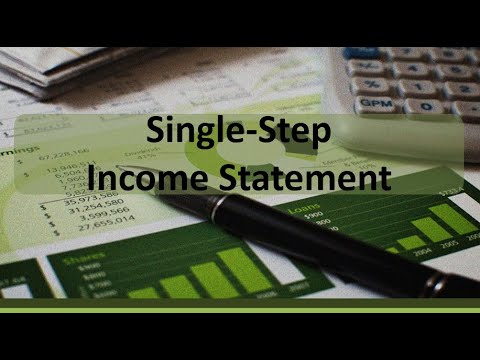How to Read and Understand an Income Statement 19 diciembre, 2022 – Posted in: Bookkeeping

The two sub-elements, gains and losses, represent the net increases and decreases in owners’ equity resulting from non-operating events, including sales of non-inventory assets, casualty losses, and other events. A lot of business owners focus their attention on the bottom line—their net profit. There’s only so much you can do to improve your bottom line by cutting expenses.
Company B Income Statement
For small businesses with few income streams, you might generate single-step income statements on a regular basis and a multi-step income statement annually. If you have more than a few income streams or a complicated financial landscape, you might use multi-step income statements to get a better view of your profits and losses. Income statement reports show financial performance based on revenues, expenses, and net income. By regularly analyzing your income statements, you can gather key financial insights about your company, such as areas for improvement or projections for future performance. Single-step income statement – the single step statement only shows one category of income and one category of expenses. This format is less useful of external users because they can’t calculate many efficiency and profitability ratios with this limited data.
Gross profit margin
Ariel Courage is an experienced editor, researcher, and former fact-checker. She has performed editing and fact-checking work for several leading finance publications, https://www.quick-bookkeeping.net/quickbooks-undeposited-funds-account-explained/ including The Motley Fool and Passport to Wall Street. This pronouncement sought to bring uniformity to the computations and presentations of earnings per share.
Corporate Finance

Your accountant is responsible for managing your tax burden and your company debt. Your income statement follows a linear path, from top line to bottom line. Think of the top line as a “rough draft” of the money you’ve made—your total revenue, before taking into account any expenses—and your bottom line as a “final draft”—the profit you earned after taking account of all expenses. However, if an organization were to act solely on the profit and loss statement, it would be neglecting all the other factors that are at play that influence an organization’s performance in the reporting period. Based on historical performance and growth rates, the organization can make assumptions about how it will perform over the next few reporting periods. The statement also shows the expenses, which are one area the organization must control to ensure they make profits.

Pick a Reporting Period
Operating losses expected to occur during phaseout are added to the net disposal gain/loss. Expected operating profits are not added to net disposal gains, but are offset against net disposal losses to the extent of those losses. The heading of the income statement identifies the entity, presents the title of the income statement, and shows the period covered by the report. However, the APB required the reporting of non-operating items as either ordinary or extraordinary. While an agreement exists on when to report gains and losses and the amount to report, two opposing positions offer the best method of presenting them to statement readers. The gains and losses are recorded as the net change rather than the gross increase and decrease in owners’ equity.
Testing Policy
And, as always, we will evaluate and reframe Dartmouth’s undergraduate admission requirements as the data and the evidence informs us. In addition to knowing whether discontinuation has taken place, the accountant also needs to know the effective date of the discontinuation to report its effects in the appropriate period. The likelihood of a recurring gain or loss from a particular type of event depends on the plans conversion cost definition formula example and decisions made by management. This approach would preclude the use of judgments about the classification of an event as operating or non-operating to distort the reported results. It is common to report only the gain of $200 rather than separately disclosing the selling price and the book value. In a qualitative sense, expenses indicate the effort expended when providing goods and services to customers.
- The final way to benchmark is by benchmarking against their historical performance.
- They also show the outcome of strategies a business sets at the beginning of a fiscal period, allowing them to make impactful adjustments to maximize profit.
- If the company is a service business, this line item can also be called Cost of Sales.
- It shows you how much money flowed into and out of your business over a certain period of time.
EBIT is helpful when analyzing the performance of the operations of a company without the costs of the tax expenses and capital structure impacting profit. Non-operating revenues are revenues that a company earns from activities that are not related to its primary business operations. Non-operating items are further classified into non-operating revenue and non-operating expenses. This is the profit before any non-operating income and non-operating expenses are taken into account. An income statement shows how effective the strategies set by the management at the beginning of an accounting period are. The first section, titled Revenue, indicates that Microsoft’s gross (annual) profit, or gross margin, for the fiscal year ending June 30, 2021, was $115.86 billion.
While primary revenue and expenses offer insights into how well the company’s core business is performing, the secondary revenue and fees account for the company’s involvement and expertise in managing ad hoc, non-core activities. Subtract the selling and administrative expenses total from the gross margin. Income statements https://www.business-accounting.net/ or profit and loss accounts are financial statements used to calculate the financial health of the company. Analyzing your income statements tells you how your company is performing here and now. But you can anticipate your future by creating hypothetical income statements for the accounting periods to come.
The statement subtracts the expenses incurred from the revenue made by the organization, which shows the report reader the organization’s level of profitability. This allows them to make the best decision about the organization’s ability to make a profit. After calculating income for the reporting period, determine interest and tax charges. As a working professional, business owner, entrepreneur, or investor, knowing how to read and analyze data from an income statement—one of the most important financial documents that companies produce—is a critical skill to have. A balance sheet shows you how much you have (assets), how much you owe (liabilities), and how much is remains (equity). It’s a snapshot of your whole business as it stands at a specific point in time.
The period labeled in the following example as “phaseout” begins with the date of the decision and extends until the completion of the process. In these two cases, the affected productive assets (that is, the machinery to produce vehicles and the aircraft) would not be separable but would remain available for other purposes. In a subsequent interpretation, the AICPA provided a series of examples of situations to be included or excluded as discontinuances. The company anticipates selling its remaining 16.75% interest for approximately $10,400,000 in interest-bearing notes.
